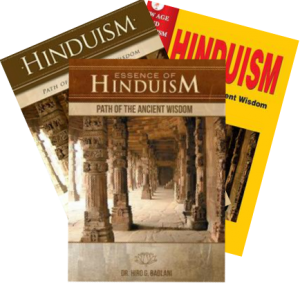Customs form over a long period. In the beginning, there is a purpose for whatever started as a custom. Over a period of time, however, the purpose is sometimes downplayed, even as the practice is continued. This makes it an empty ritual.
Om is the Hindu icon for the Divine:
Om became the Hindu symbol of the transcendental Divine. It is very commonly used as a beginning of all ceremonial mantras and slokas. Shaanti Shaanti Shaanti: Shaanti, or peace, is regarded as a most auspicious word. Hindus repeat it thrice to make it more emphatic and assertive.
Hindus wear a forehead mark: Historically, both men and women wore a mark on the forehead, but nowadays most men prefer not to apply a mark, except during religious or auspicious ceremonies. Hindu women continue to wear the mark, which has become famous as the bindi. It is applied between the two eyes and is usually red in color. This mark, or tilak, as it is mentioned in the ancient Sanskrit scriptures, symbolically represents the third eye, the spiritual eye. With this mythological eye the person may acquire the inner sight that is not perceived with the physical eyes.
Namaste or Namaskar:
A traditional Hindu way of greeting with folded hands is now becoming popular even among non-Hindus. It is spiritual; it conveys, “I bow before the Divine in you!” It is, indeed, a more hygienic, non-aggressive, and graceful way of greeting than the Western custom of shaking hands or hugging.
Touching feet of the guru, parents, and elders: Hindus have raised the status of mother and father to the level of God. In traditional Hindu families, it is a common practice to bow down and touch the feet of parents and elders and seek their blessings, or asheervaad. Although many do not observe this practice in modern society, others continue to do so with great warmth and enthusiasm, even when they settle in Western countries.
Tiruvadi:
Hindus worship the sacred sandals worn by saints, sages, and satgurus. Hindus worship Tulasi, the basil plant:
Tulasi occupies a very exalted position in Hindu mythology. Tulasi becomes wedded to Lord Vishnu. It also represents an honor to the agriculture product in Hindu society. Ayurveda has described many good benefits accruing from the use of the basil plant.
The coconut is used in the worship ceremony:
Kalasha, a husked coconut circled by mango leaves on a pot, is used in puja to represent any God; especially Lord Ganesha. The breaking of a tough coconut shell is compared to breaking the ego.
Rudraksha:
Hindus revere and worship with rosary, mala, made of the Rudraksha seeds. It is especially associated with prayers for Lord Shiva:
Hindus often light the wick of an oil lamp in the evening:
This may be substituted by burning an incense stick, agarbati or dhoop. The light is symbolic of a spiritual inner awakening. Lighting a lamp is symbolic of removing the darkness and bringing the knowledge of spiritual wisdom. Now many prefer battery candles to avoid fire. Hindus offer prayers before meals: It is customary for Hindus to offer prayers before starting their meals. Food is considered as Prasad, the Divine blessing, and therefore is considered very auspicious and sacred in Hindu society.
Shoes:
Many Hindus do not wear shoes inside the home; shoes are regarded impure and unhygienic for temple and home. Even those living in foreign countries often observe this custom, occasionally in very severe cold weather also!
Hindus observe vrat, or fasting:
It is common for Hindus to observe vrat, or fasting, on some religious days, such as Ekadasi. Essentially, it is a token of a self-restraint. It may be in other forms, such as a vow to observe silence (maun vrat) for one or more days, as Mahatma Gandhi often did. It is a self-willed determination, sankalpa, to purify oneself with some type of physical austerity. It is also a period of time when one remains dedicated to the virtue of God and refrains from any evil thought, word, or deed. Hindus have earmarked special days for each deity:
Monday is Lord Shiva’s day of prayers and fasting.
Tuesday is for Lord Ganapati.
Thursday is dedicated to goddess Lakshmi and Sai Baba.
Friday is devoted to Santoshi Mata.
Saturday is sanctified as Lord Hanuman’s day.
Havan Kund:
This is a temporary fire made by burning pieces of wood in a specially erected platform. It is the legacy of the ancient ritual of Vedic period.
Sacraments, samaskars, associated with various life stages:
For the Hindu, life is a sacred journey in which each milestone, marking major biological and emotional stages:
Ceremonies associated with childbirth:
Hindu society has given the highest importance to the upbringing of children:
The namakarana-naming ceremony-occurs in the temple or home, eleven to forty-one days after birth.
Head shaving (mundan or chudakarana) is performed at the temple between the child’s thirty-first day and fourth year.
The annaprashana celebrates the child’s first solid food, when sweet rice is fed to the baby.
Upanayana:
The thread ceremony is performed to herald puberty and adolescence of the male child. It is equivalent of the baptism in the Christian religion. In early times, the boy would be initiated in the training of sacred scriptures. Thus, it would be hailed as the time of being twice born. The second birth coincides with spiritual training.
Last rites:
Hindus have a fascinating relationship with death. According to the Hindu philosophy, the physical body is considered unreal self, as compared to the imperishable soul, which is regarded the eternal and undying self. The phenomenon of death of the body, however, is always regarded as most sacred and eventful in the family. Traditionally, a person is brought home when the end is in sight so that the death occurs among loved ones in the family, rather than in the alien atmosphere of the hospital. A lamp is lit near the head, and mantras are chanted, such as Aum Namo Narayana or Aum Namo Shiva. At the very last moments of life, holy water—Ganagjal, water from River Ganges—or few drops of milk and honey are trickled into the mouth. The holy songs, bhajans, or tapes of spiritual instrumental music are played in low volume to purify the atmosphere. Hindus generally cremate their dead. The body of the departed is given a bath and dressed in fresh clothes. Fragrant sandalwood paste is applied to the corpse, which is then decorated with flowers and garlands. Traditionally, after scriptural chants and cremation rituals (antyeshti) by the priest, the body is placed on the funeral pyre. Nowadays, cremation is done in the electric crematorium in many urban places and in foreign countries. Embalming is usually not favored, but is commonly performed in the foreign countries.
The Hindu custom of creamating the dead bodies is now becoming more popular in US also. 41 % of population prefers cremation over burial for more practical reasons. Mark Twain, (in 1896) said: “We are drifting slowly, but hopefully toward cremation. When cremation becomes the rule, we shall cease to shudder; we should shudder at burial if we allowed ourselves to that what goes on in the grave.”
Shraddha—the ceremony in memory of the departed souls:
Hindus perform a ritual ceremony in memory of their deceased parents. They invite their family priest to conduct the rites, which are followed by family meals together. Many Hindus have discarded this ceremony, although some observe it very solemnly. There are others who do not call the priest, but family members get together and partake of meals after doing worship, or aarti.
For Hindus, life is a sacred journey in which each milestone is sanctified with sacraments and rites. The holy ceremonies are meant to empower spiritual perspective in individuals and families. Some customs have a harmful effect, too. The poisonous custom of inequality among castes, gender, and other attributes are a slur on Hindu society. Sri Tapovan Maharaj said, “Alas! Think how customs get the better of man and enslave him! Every intelligent man ought to know that customs are made for man, not man for custom.” 95
Om has remained an icon for the Divine, and, continues to be used emphatically. People often use “HariOm” while addressing each other.
Use of “Tilak” has reduced significantly in public, although its use during the “Puja” ceremony is still quite popular.
“Namaste” as a word of greetings, is getting popular even in Western countries. It is less aggressive, more hygenic, more meaningful, and very spiritual.
Touching feet of the guru, parents, and elders etc. is an ongoing tradition in the Hindu society. Some people follow this tradition earnestly even after growing old and acquiring high positions, although many others do not now!
Offering prayers before meals in homes remains in vogue, although not by majority.
Removing of shoes before entering is observed very firmly in Hindu temples. However, some temples in foreign countries like the “Vedanta” temples allow the wearing of shoes inside their premises. Many modern temples make suitable arrangements in covered areas for devotees to remove their shoes while sitting comfortably on chairs; the shoes are kept in a place well-protected from rain etc. A carpet passage is usually provided to protect devotees from cold and accidental injury.
Vrat, or fasting on “special religious days” is still quite popular. Some occasions like “Karwa Chauth”-when women observe a fast as a prayer for their husband’s long lives
“Havan Kund” remains quite popular in many places. The “Fire” is nowadays reduced to avoid accidents and smoke.
Sacraments—samaskars–associated with various life stages are observed with variation. The Namakarana-naming ceremony, Mundan or Chudakarana-the Head shaving ceremony, the Upanayana-the thread ceremonies etc. are becoming less popular, although some do observe them very religiously.
“Last rites” after the death are observed faithfully by most. Often a big Puja, followed by serving food to many guests is organized in memory of the departed. Feeding the ‘Brahmins’ as per old traditions is becoming less popular. Even the yearly “Shraddha ceremony” is performed by many with some modifications.
In Hindu society, customs are usually performed softly, according to one’s individual choice and preference; no pressure is felt from religious authorities.
Although many do not observe the practice of touching the feet of in modern society, others continue to do so with great warmth and enthusiasm, even when they settle in Western countries.
Tulasi becomes wedded to Lord Vishnu. It also represents an honor to the agriculture product in Hindu society. Ayurveda has described many good benefits accruing from the use of the basil plant. Lighting a lamp is symbolic of removing the darkness and bringing the knowledge of spiritual wisdom. Now many prefer battery candles to avoid fire. Many Hindus have discarded the ceremony of shradha, although some observe it very solemnly, even in foreign counties. There are others when family members get together and partake of meals after doing worship, or aarti.




